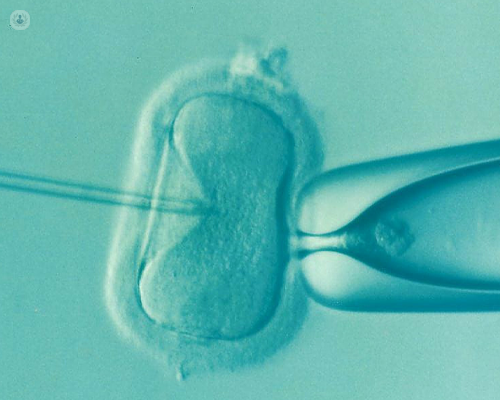Tubal factor infertility
What is tubal factor infertility?
Tubal factor infertility refers to a type of female infertility caused by damage or dysfunction of the fallopian tubes. The fallopian tubes play a vital role in natural conception, as they are responsible for transporting the egg from the ovary to the uterus and providing the site where fertilisation occurs. When these tubes are blocked, scarred, or damaged, they may prevent the egg and sperm from meeting, resulting in difficulties with conception.

The condition may involve complete blockage of one or both fallopian tubes or partial damage that affects their function. It can also include conditions like hydrosalpinx, where the tubes become swollen and filled with fluid, further impairing their ability to function properly.
Is tubal factor infertility common?
Tubal factor infertility is a common cause of female infertility and is estimated to account for around 25 to 35 per cent of cases. It affects women of all ages but is more prevalent among those with a history of pelvic infections, previous abdominal or pelvic surgeries, or certain medical conditions that increase the risk of tubal damage.
In the UK, many cases of tubal factor infertility are linked to untreated sexually transmitted infections (STIs) such as chlamydia or gonorrhoea. Other causes include pelvic inflammatory disease (PID), endometriosis, and complications following abdominal surgeries. Early diagnosis and treatment of these underlying conditions can reduce the risk of developing tubal infertility.

How is tubal factor infertility diagnosed?
Diagnosing tubal factor infertility typically involves a combination of medical history, physical examinations, and imaging tests. A fertility specialist will often begin by reviewing the patient’s medical and reproductive history, including any past infections, surgeries, or symptoms of pelvic pain.
One of the most commonly used diagnostic tests is a hysterosalpingography (HSG). This X-ray procedure involves injecting a contrast dye into the uterus and fallopian tubes to assess whether they are open or blocked. The flow of the dye provides valuable information about the structure and function of the tubes.
Another method is a saline infusion sonography (SIS) or saline sonohysterogram, where saline and sometimes air are introduced into the uterus during an ultrasound to visualise the uterine cavity and fallopian tubes. For more detailed imaging, a laparoscopy may be performed. This minimally invasive surgical procedure uses a small camera inserted through a tiny incision in the abdomen to directly view the fallopian tubes, ovaries, and surrounding structures.
In some cases, additional tests such as pelvic ultrasounds or magnetic resonance imaging (MRI) may be recommended to provide further insights into underlying issues like endometriosis or adhesions.

What are the treatment options for tubal factor infertility?
Treatment for tubal factor infertility depends on the severity and type of tubal damage, as well as the patient’s overall health, age, and reproductive goals. Common approaches include medical management, surgical interventions, and assisted reproductive technologies (ART).
For mild cases where the tubes are partially damaged but not completely blocked, surgical procedures may be performed to repair or open the tubes. Laparoscopic surgery is often used to remove adhesions, scar tissue or blockages. In cases of hydrosalpinx, the damaged portion of the tube may be removed or clipped to improve the chances of successful in-vitro fertilisation (IVF).
When surgery is not feasible or successful, ART, particularly IVF, becomes the most effective option. IVF bypasses the fallopian tubes entirely by retrieving eggs directly from the ovaries, fertilising them in a laboratory, and transferring the resulting embryos into the uterus.
In some situations, a combination of surgical treatment and IVF may be recommended to maximise the chances of conception.
How successful is IVF for someone with tubal factor infertility?
IVF is highly effective for individuals with tubal factor infertility, as it eliminates the need for functioning fallopian tubes. Success rates for IVF vary depending on factors such as the patient’s age, the quality of the eggs and sperm, and the expertise of the fertility clinic. For women under the age of 35, live birth rates per IVF cycle can exceed 40 per cent, while rates tend to decline with age.
For patients with hydrosalpinx, removing or clipping the affected fallopian tubes before starting IVF significantly increases the likelihood of a successful pregnancy. This is because the fluid in a hydrosalpinx can leak into the uterus and interfere with embryo implantation.
Overall, IVF offers hope to many individuals with tubal factor infertility who might otherwise have limited options for achieving a pregnancy.

What's involved in surgery for tubal factor infertility?
Surgery for tubal factor infertility is aimed at restoring the normal function of the fallopian tubes. The specific procedure depends on the type and extent of tubal damage. Common surgical approaches include tuboplasty, which involves repairing or reconstructing the tubes, and salpingectomy, which involves removing damaged or diseased portions of the tubes.
For women with adhesions or scar tissue, a surgeon may perform adhesiolysis to free the tubes from surrounding tissues. In cases of hydrosalpinx, the affected tube is often removed or clipped to prevent fluid from impacting fertility treatments such as IVF.
These procedures are typically performed laparoscopically, offering the advantages of smaller incisions, reduced recovery times, and lower risks of complications compared to open surgery. Recovery times vary depending on the complexity of the surgery, but most patients can return to normal activities within 1 to 2 weeks.
It is important to note that the success of tubal surgery depends on the extent of the damage and the presence of other factors affecting fertility. In some cases, surgery may not fully restore fertility, and IVF may still be recommended.

Which specialist treats tubal factor infertility?
Tubal factor infertility is treated by fertility specialists, often working within multidisciplinary teams at fertility clinics. A fertility specialist is typically a consultant gynaecologist with additional training in reproductive medicine and surgery. These experts are equipped to diagnose and manage a range of infertility conditions, including those related to the fallopian tubes.
For surgical treatments, a specialist in reproductive surgery may perform procedures to repair or remove damaged tubes. In cases requiring ART, such as IVF, the fertility specialist oversees the process, from ovarian stimulation to embryo transfer.
Seeking care from an experienced fertility team ensures that patients receive comprehensive evaluation and personalised treatment plans tailored to their specific needs. Early consultation with a specialist can improve outcomes and help patients explore the most suitable options for achieving their reproductive goals.